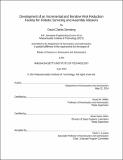Development of an incremental and iterative risk reduction facility for robotic servicing and assembly missions
Author(s)
Sternberg, David Charles, Ph. D. Massachusetts Institute of Technology
DownloadFull printable version (3.870Mb)
Other Contributors
Massachusetts Institute of Technology. Department of Aeronautics and Astronautics.
Advisor
David W. Miller and Alvar Saenz-Otero.
Terms of use
Metadata
Show full item recordAbstract
A means for reducing the risk for an on-orbit robotic servicing and assembly mission through the development of a series of testbeds that build successively upon one another is investigated. Robotic Servicing and Assembly (RSA) missions are believed to enable life extension programs for existing spacecraft while also enabling much larger and more complex satellites to be developed through on-orbit construction. Unfortunately, many of the new and innovative technologies required for RSA to be economically and technically feasible are still in their formative development stages. Consequently, such RSA missions are highly risk prone. This thesis investigates the development of an incremental and iterative testing facility which can be used to reduce these RSA risks by conducting demonstration testing in authentic operational environments while leveraging existing infrastructures to reduce the costs associated with testing. The Defense Advanced Research Project Agency's (DARPA) Phoenix project, a satellite repurposing mission, serves as an example of a full-scale flight mission requiring risk-reduction testing. The thesis presents research that shows how the newly developed testing facility, which expands on the Synchronized Position Hold Engage and Reorient Experimental Satellites (SPHERES) facility, can reduce the risk of many technologies required for Phoenix. In particular, testing is discussed and analyzed for the risk reduction of resource aggregation and physical reconfiguration technologies. This testing is both incremental and iterative in nature as part of two ground test programs and a flight program aboard the International Space Station. The testing progression matures these technologies from base principles tested in the ground environment at the MIT Space Systems Laboratory to the planned implementation aboard the International Space Station prior to the final flight mission. The newly developed testing facility is small in scale as compared to the final RSA flight satellites, so newly developed scaling laws are presented. This process relies on the scaling of testbed results using the combined application of hybrid scaling laws and nondimensional parameters. In doing so, the results from the new testing facility can be applied to the Phoenix mission to raise the probability of mission success.
Description
Thesis: S.M., Massachusetts Institute of Technology, Department of Aeronautics and Astronautics, 2014. This electronic version was submitted by the student author. The certified thesis is available in the Institute Archives and Special Collections. Cataloged from student-submitted PDF version of thesis. Includes bibliographical references (pages 138-142).
Date issued
2014Department
Massachusetts Institute of Technology. Department of Aeronautics and AstronauticsPublisher
Massachusetts Institute of Technology
Keywords
Aeronautics and Astronautics.